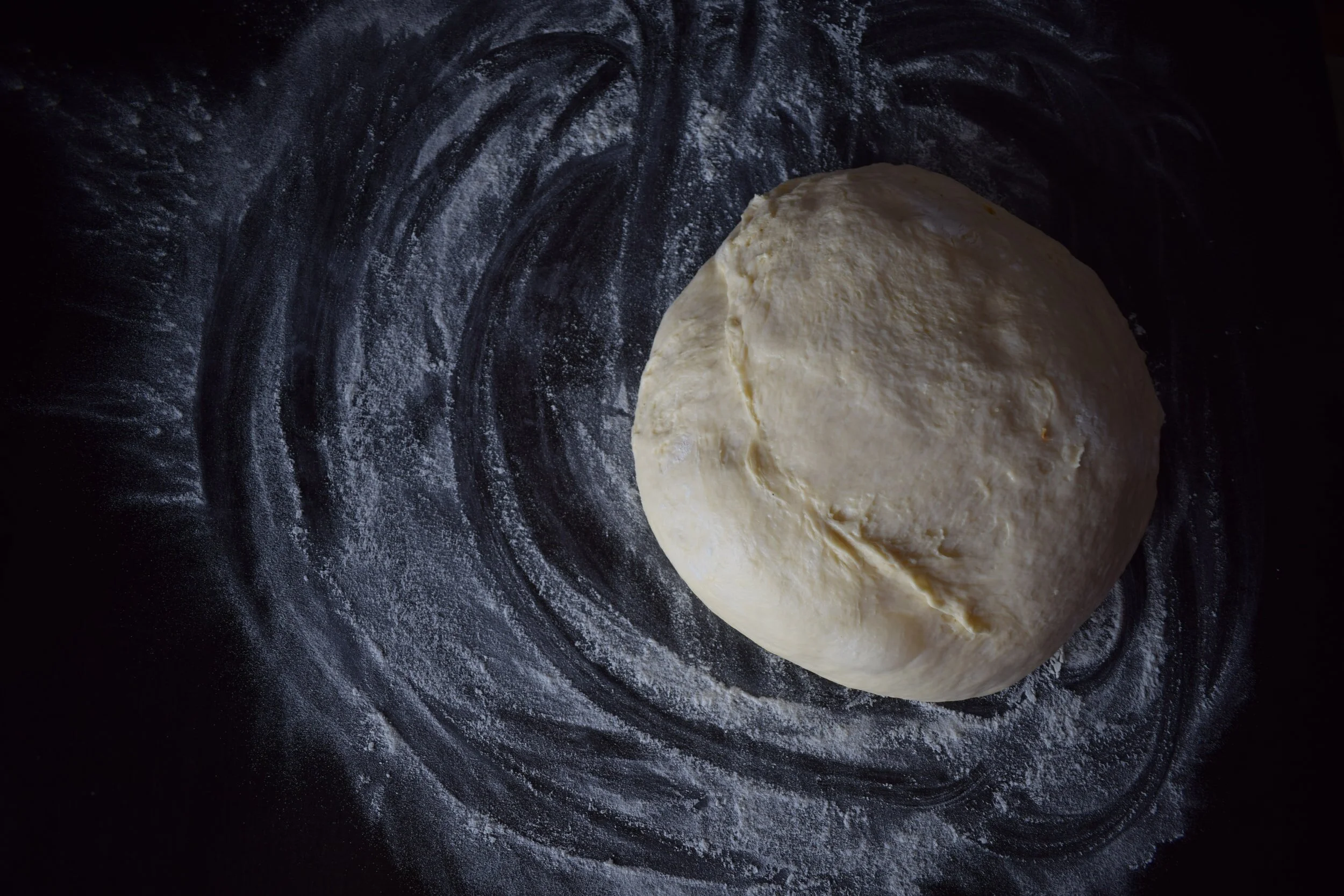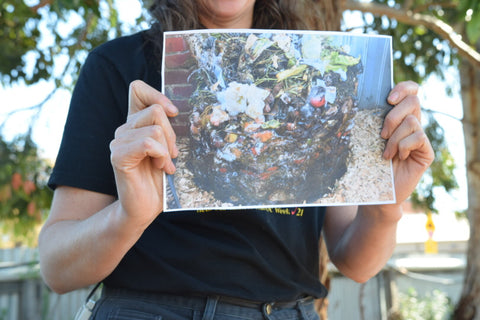INTRODUCTION TO SOURDOUGH
Some basic knowledge about working with sourdough.
There is much to tell and explain about sourdough, and it can be daunting to start with, as there are several variables in the process. But just as learning to walk, practice makes perfect. This manual is guide that will help you explore the world of sourdough. It gives a basic explanation of sourdough and some its key elements. There are instructions for creating and maintaining a starter (the ‘motor’ of the bread dough) and for mixing and developing a dough into a wonderful sourdough bread.
Organic flour
Apart from a health benefit, it is best to use organic flour when you are creating a starter and baking bread. Organic flour has all the right bacteria and wild yeast available that are needed to get the starter going and create a great tasting bread. The bacteria determine the flavour of your bread and the wild yeast make you bread rise and give it an open structure (or crumb). These two essential sourdough elements are predominantly present on the bran of the wheat grain. By using organic flour, the bacteria and wild yeast are mostly intact and alive.
Temperature
The ambient temperature and the dough temperature will determine the development of the dough. Simply put, a lower temperature will slow down the development of yeast and bacteria, a higher temperature will encourage yeast and bacteria growth. Example: with an ambient temperature of 20°C, it can take up to 10-12 hours to develop and bake a bread, whereas with and ambient temperature of 28°C,it can take up 5-7 hours. There are ways to tweak the temperature of the dough and with control the fermentation. During winter the ambient temperature can be too low for the dough to rise and create the right taste for the bread in the end. By using warm water, approximately 30-35°C, the dough temperature will be higher in the beginning and kick start the necessary fermentation. At the time, in summer it will be good to use cooler water, in order not to let the dough over ferment. Take this into account, and in time you will be able to use it as a tool to control the fermentation of the dough and fit sourdough baking in your daily schedule.
Hydration
When working with sourdough it is always best to use filtered water. Tab water contains chlorine, which interferes with the sourdough bacteria. It can not only inhibit the fermentation process, but it will also affect the taste of the final bread. Besides filtered water, the amount of water in a starter and dough will have an impact on the fermentation and in case of the dough, the strength of that dough. More water in a starter means an enhanced fermentation, less water will slow the fermentation down. By adding more water to the dough, it will be easier to work with, but it will be more difficult to create the necessary strength. Before playing around with water content in the dough it is wise to first get acquainted with other parts of the sourdough bread baking process.

CREATING A STARTER
What do you need
- Clean and sterilized jar, approximately 500ml
- Clean spoon (preferably wood) and silicone spatula
- A mixture of organic white bakers flour and organic whole wheat flour, in the ratio of 50-50
or
-A mixture of organic rye flour and organic whole wheat flour, in the ratio 50-50. The usage of rye flour will make it easier to get the starter going. The starter will be much stiffer, and rye will bring a different taste profile.
A good temperature to create a new starter is around 25°C. If the ambient temperature falls below 20°C, it is best to use warm water (approximately 30-35°C).
Day 1
Mix 40 grams of flour with 40 grams of water. Store at room temperature out of direct sunlight for 24 hours.
Day 2
Maybe something is already happening, if not no worries. Add 20 grams of flour and 20 grams of water. You can stir the starter 2 or 3 times a day to help the development, but this is not necessary. Store at room temperature out of direct sunlight for 24 hours.
Day 3
Your starter could be getting active at this stage, depending on the ambient temperature. If still not much is happening, throw away half of the starter and repeat the instruction of day 2. If you already see some air bubbles and it looks like the starter has risen, throw away 2/3 and add 30 grams of flour and 30 grams of water. Store at room temperature out of direct sunlight for 24 hours.
Day 4
At this stage the starter should be active and strong enough to double in size. It needs one more feed before you can start baking with it. Throw away 2/3 and mix the rest with 30 grams of flour and 30 grams of water. Store at room temperature out of direct sunlight for 24 hours. If nothing has happened or the starter did not double in size, throw away half and repeat the instruction of day 3.
Day 5
The starter should now be doubling in size after each feed and be ready for baking. If it is still not doubling, repeat the instructions of day 3 and 4 and place the jar in a warmer spot. Discarding some starter and replacing it with fresh flour and water is called a refreshment. After each refreshment, the starter will get stronger and double or even triple in size.
Day 6 and onwards
From now on it is best to refresh the starter every 12 hours, certainly when the ambient temperature is around 22-25°C. In order not to discard too much starter after each refreshment, it is best to refresh the starter from now on in the ratio of 1:2:2. This means 1 part starter, 2 parts flour, 2 parts water. In weight this means 25 gram starter, 50 gram flour and 50 gram water.
Active and ready starter; when to bake?
Before starting to bake bread with the starter it is a good exercise to observe it. At first the starter will double or almost triple. Visually it will maintain this level for a while. But this does not mean it will be ready to bake. Inside the starter, the fermentation continues and the strength of the starter will further increase. At one point the starter will start to sink. This means it is time to refresh it again and won’t have the necessary strength and flavour, needed to bake a bread. A good test to check if the starter is ready to use in a dough is to do the float test. Take a small spoonful of starter and drop that in some water. If the bit of starter flows, it means there is enough air, and with that enough active yeast cells, in the starter to lift the bread dough. If not, it needs more time.
MAINTAINING A STARTER
Storing
For most home bakers is does not make sense to maintain and refresh a starter daily. Luckily there is the possibility of storing the starter in the fridge. When you decide to do this, simply refresh the starter with 100 grams of flour, 80 grams of water and 20 grams of starter. A lower amount of water and starter will mean the fermentation is slowed down. Wait until you see some activity, this doesn’t need to be much and will be visible after a couple of hours. If something is happening you can store the starter in fridge.
Refreshing after storing in the fridge
When you decide, you want to bake a bread it is important to first refresh the starter a couple of times. After a while in the fridge the starter can smell a bit sour, but above all it won’t have enough strength to create a good bread. Take your starter out of the fridge and leave it to get to room temperature, this takes approximately an hour, depending on the ambient temperature. Once the starter has warmed up, refresh it with the ratio of 1:2:2 (starter:flour:water). Do this at least 3 times, to give the starter the necessary strength and flavour. If the ambient temperature falls below 20°C, it is best to use warm water (approximately 30-35°C).
Baking
Once the starter is active (again) it is time to use it. There are two options.
1. If you are planning on baking just 1 bread, it is enough to slightly increase the quantities of the refreshment (e.g. 30:60:60). This will make sure there is enough starter to use in the dough, as well as some starter that can be used to refresh it and keep it going.
2. Another option is making a levain with a bit of the starter. Once the starter is used in the dough, it is called a levain. This is useful when you plan on baking more than 1 bread, and the regular starter amount (and jar!) is not enough. To build the levain, which is nothing more than an offshoot of the starter, use the same feeding ratio as when refreshing the starter. The only difference is that you will need to scale up the ingredients to create the necessary amount of levain.
MAKING A BASIC COUNTRY BREAD
INGREDIENTS
Levain (offshoot of the starter) 100g
Organic White flour 400g
Organic Whole Wheat flour 100g
Salt 10g
Water 375g
PROCESS
Before you start making the dough, refresh the starter, and let it develop overnight at room temperature.
1. Mix all the flour and the water (30-32°C), either by hand or with a spoon, the dough will look like a shaggy mass. Let it rest for at least 30 minutes. This step is called autolyse, and will improve gluten development. It allows the flour to completely absorb the water.
2. Mix the dough First add the salt and then add the required amount of levain. Mix by hand, first by squeezing the dough for 20-30 seconds. After that stretch and fold the dough. If necessary pinch the dough between your thumb and forefinger. The dough will become smoother as you progress. This step will take roughly 2-3 minutes.
3. Bulk stage:
Stretch and fold
Once the dough is mixed, leave it for 30 minutes. After this rest perform a set of 4 stretch and folds. Again, leave the dough to rest for 30 minutes. Repeat this step 4 more times, with 30 minutes intervals. This step is necessary to align the gluten structure and create strength in the dough. If the dough feels already strong and tight before finishing the described stretch and folds, it is better to stop.
4. Bulk stage:
Fermentation
After the stretching and folding leave the dough to rest. Let the dough rise until it has doubled in size.
5. Shaping With wet hands take the dough out of the bowl or tub you are using. Flip one side on to the other and with your hands or a dough scraper, shape it into a boule or batard. Make sure to create some surface tension, otherwise the dough will flat out during the bake. Dust a proofing basket or bowl with a towel, with a mixture of white flour and rice flour (50/50). Place the dough in the proofing basket and cover it. Alternatively, you can also use a bread tin. This might be easier in the beginning as you have less to worry about dough strength.
6. Proofing
Proofing can take around 3 hours at room temperature. Using a floured finger to poke the dough will give you an indication if the loaf is ready to be baked. If the dough springs back immediately it needs more proofing. If it springs back slowly, it is ready to be baked. Does the dough not spring back at all, then it is over-proofed.
Proofing: fridge After shaping the bread, there is also the option of putting the dough in the fridge. This is helpful when you want to bake a fresh bread the next morning or when you don’t have time to bake. Put the basket or bowl in a plastic bag, so the dough won’t dry out and bake when you are ready straight from the fridge.
7. Bake How a bread is baked, all depends on the method used and tools you have available. The description below is for baking a bread in a Dutch oven. Pre-heat the oven with the Dutch oven inside to the highest possible temperature. For most domestic ovens this is around 250°C. Once the oven and pans are preheated, take a piece of parchment paper and put that on a board or peel. Flip the dough out of the bowl or basket on the paper and slide it in the pan. Bake the loaf at 230°C for 25 minutes. After this take lid of and bake for another 10-15 minutes. The bread is done when the crust has a deep golden brown colour. Once the loaf is out of the oven you can tap the bottom, if it sounds hollow it is properly baked.
Leave to cool, before slicing it.



